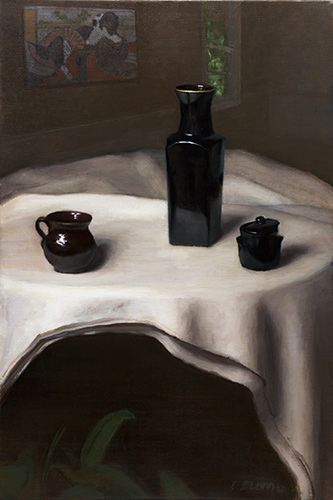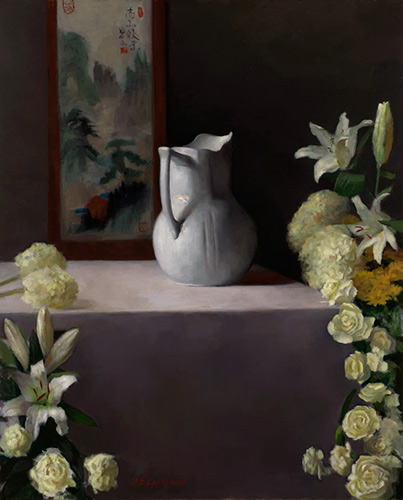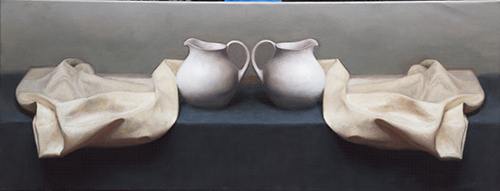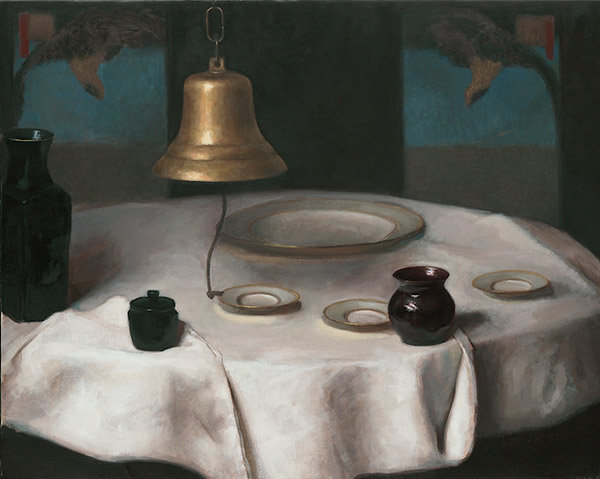While the “purpose” and “meaning” of art is an ever-evolving concept — surely open to the artist’s subjective interpretations — the creative process frequently seems to be grasping at something beyond the light that enters our eyes and brains. Plumbing the visual in search of the invisible is painter Dana Levin, whose masterful still life and portraiture speak to “ideas that are too big and esoteric for language.”
Some artists create finished products that closely resemble their original concepts and sketches; others begin with an embryonic idea that blossoms into something different. Painter Dana Levin belongs to the latter group, remaining flexible during a picture’s development and allowing multiple sources of visual information to flow organically. A masterful still life painter and portraitist, Levin allows herself to question her artistic decisions at every phase of the process. She writes, “If something needs to be changed I change it, no matter what stage the painting is in. I am always looking for the highest potential of each painting.” The task is undoubtedly challenging for Levin — or for any artist — but her results are unquestionable.

Dana Levin, “Twirl,” oil on canvas, 18 x 24 in. (c) Dana Levin 2015
“Painting reconciles the world inside with the world outside,” Levin says. “The ideas that are too big and esoteric for language. There are images that come into my brain that I need to see outside my head in order to fully understand them. There are objects I see that I feel compelled to interpret in paint because they represent something other than what they appear to be.” In this way, Levin’s still life work is taken beyond its traditional genre roots. “‘New Earth’ is a good example of this,” says Levin. “You would never walk into a room and see a table like this with a bell hanging and Japanese wood block prints in the background depicting eagles. I had been studying the universe, planets, time, and the time-line since creation. I was thinking about Earth’s relation to the rest of the universe in this piece. Of course it is not the only interpretation, but that was my original idea.”

Dana Levin, “Earth and Sky,” oil on canvas, 18 x 24 in. (c) Dana Levin 2015
Representing the figure, especially via portraiture, presents different challenges for the artist. For Levin, all the information she needs lies in the sitter’s visage and “switching between two modes of observation,” she says. “On the one hand you want to objectify the sitter so you can accurately see the forms and shapes of their face. My eye utilizes the same critical function to understand the forms of a teapot and the human head. However, people are not a bunch of shapes. If I cannot transmit that the human being is far more profound — what’s the point of making art?”
Levin’s renown as a portraitist serves as evidence that she’s established a solution. How does she do it? “I try to erase myself,” she says. “I erase my judgment and my personality from the experience. In this way the visual information will determine the character of the sitter in the painting, not my mood. All the information passes through me, through my temperament, but the painting is about the sitter, not about how I feel about the sitter.” This approach can be traced to the artist’s tenure at the Florence Academy of Art. Levin writes, “I remember as an art student drawing the torso on a model. I had drawn from the nude many times before and so many times after, but I still remember this intense moment: I was observing the forms of the ribs and the changes in value on the belly. I was drawing through a filter of ‘artistic anatomy.’ As the model was breathing I could see the ribs rise and fall. All of a sudden, I thought about the lungs and intestines and all the organs underneath. I thought about the blood pumping through the veins and the heart beating. I thought, ‘Never forget the big picture.’ A figure painting should have presence. When you are in a room alone with a painting, it should feel like company.”

Dana Levin, “Lovers,” oil on canvas, 20 x 30 in. (c) Dana Levin 2015
In both her still life and portraiture, Levin achieves the presence she’s after with breathtaking beauty, and collectors continue to come knocking at her studio door. “I hope viewers can feel that when there is a vase in my work, it represents something more than an object,” she says. “It’s a wonderful feeling when someone ‘gets’ my artwork in the same way that I intended it. But I also feel that paintings have a life of their own. They will be interpreted through the perspective of the viewer — and perspectives change.”

Dana Levin, “The Wedding Painting,” oil on canvas, 24 x 30 in. (c) Dana Levin 2015
Levin continues to forge ahead, suggesting, “I am a mystic. I am also a representational painter. I am obsessed with things I cannot see but am inspired to express those ideas through objectified art. It is a challenge, and I expect to be struggling with it for some time!”

Dana Levin, “Symmetry,” oil on canvas, 20 x 40 in. (c) Dana Levin 2015
Currently, Levin appears to be focusing predominantly on her still life, but her figurative work remains on queue. “I am still excited about still life,” she writes. “I will continue to employ it to explore and express more complex ideas. I took a break from figure work but am getting back into it now. I have started sketching images of two figures together. I found a couple to model for me so I can develop the idea more. So we will see what comes of that!” We will wait, with confidence, on the gifts to follow.
To learn more, visit Dana Levin.
This article was featured in Fine Art Today, a weekly e-newsletter from Fine Art Connoisseur magazine. To start receiving Fine Art Today for free, click here.








